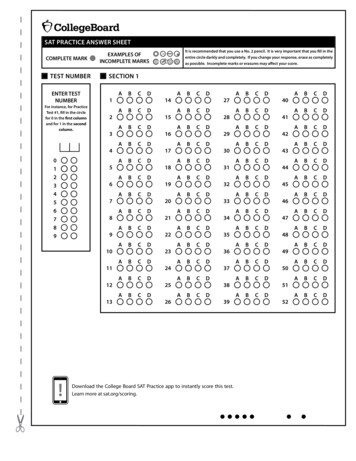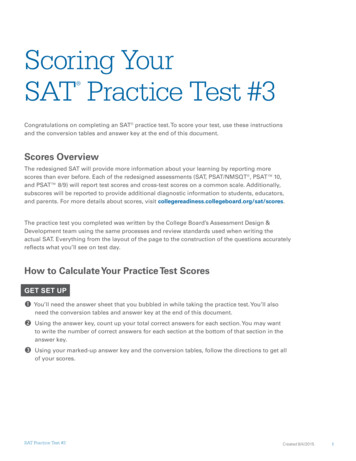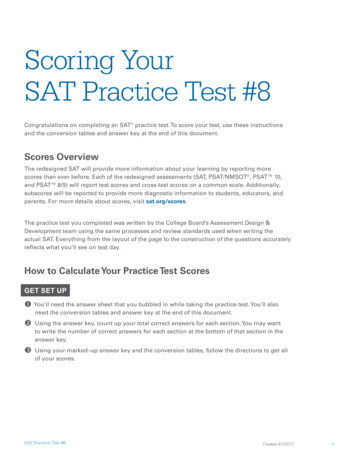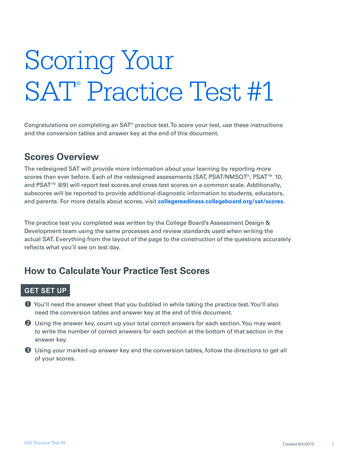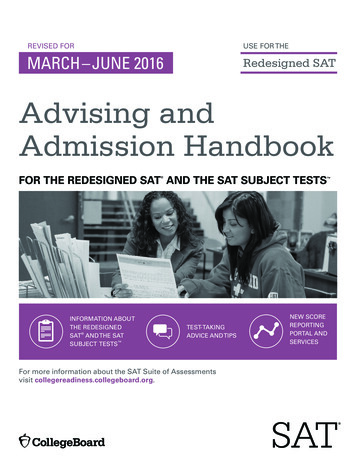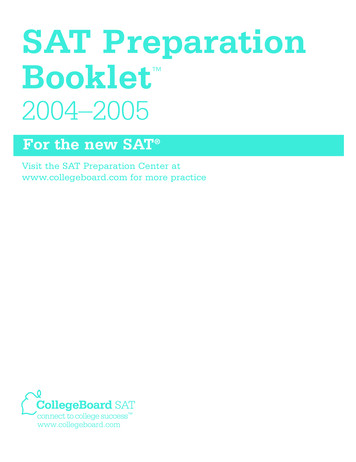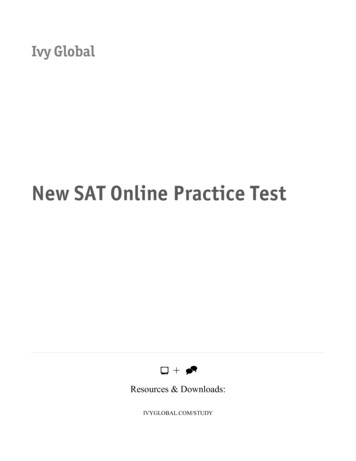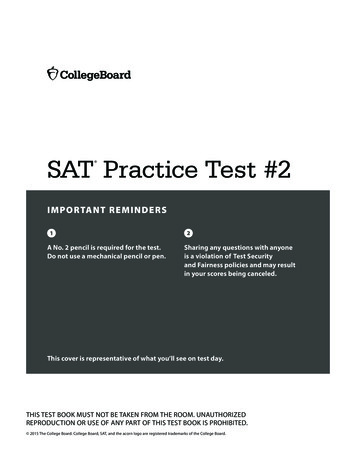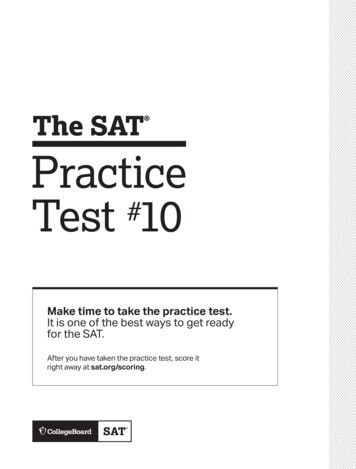
Transcription
The SAT Practice#Test 10Make time to take the practice test.It is one of the best ways to get readyfor the SAT.After you have taken the practice test, score itright away at sat.org/scoring.
THIS PAGE IS INTENTIONALLY LEFT BLANK.
Test begins on the next page.
11Reading Test6 5 M I NU TES, 5 2 QUESTIONSTurn to Section 1 of your answer sheet to answer the questions in this section.Each passage or pair of passages below is followed by a number of questions. After readingeach passage or pair, choose the best answer to each question based on what is stated orimplied in the passage or passages and in any accompanying graphics (such as a table orgraph).This passage is adapted from Mary Helen Stefaniak, TheCailiffs of Baghdad, Georgia: A Novel. 2010 by Mary HelenStefaniak.Line510152025Miss Grace Spivey arrived in Threestep, Georgia,in August 1938. She stepped off the train wearing apair of thick-soled boots suitable for hiking, a navyblue dress, and a little white tam that rode the wavesof her red hair at a gravity-defying angle. August wasa hellish month to step off the train in Georgia,although it was nothing, she said, compared to the119 degrees that greeted her when she arrived onetime in Timbuktu, which, she assured us, was a realplace in Africa. I believe her remark irritated some ofthe people gathered to welcome her on the burnedgrass alongside the tracks. When folks are sweatingthrough their shorts, they don’t like to hear that thisis nothing compared to someplace else. Irritated ornot, the majority of those present were inclined to seethe arrival of the new schoolteacher in a positivelight. Hard times were still upon us in 1938, but, likemy momma said, “We weren’t no poorer than we’dever been,” and the citizens of Threestep were in themood for a little excitement.Miss Spivey looked like just the right person togive it to them. She was, by almost anyone’sstandards, a woman of the world. She’d gone toboarding schools since she was six years old; she’dstudied French in Paris and drama in London; andduring what she called a “fruitful intermission” in herformal education, she had traveled extensively in theUnauthorized copying or reuse of any part of this page is illegal.Unauthorized copying or reuse of any part of this page is illegal.298.Questions 1-10 are based on the followingpassage.230354045505560Near East and Africa with a friend of hergrandmother’s, one Janet Miller, who was a medicaldoctor from Nashville, Tennessee. After her travelswith Dr. Miller, Miss Spivey continued her educationby attending Barnard College in New York City. Shetold us all that at school the first day. When my littlebrother Ralphord asked what did she study atBarnyard College, Miss Spivey explained thatBarnard, which she wrote on the blackboard, was thesister school of Columbia University, of which, sheexpected, we all had heard.It was there, she told us, in the midst of trying tofind her true mission in life, that she wandered oneafternoon into a lecture by the famous John Dewey,who was talking about his famous book, Democracyand Education. Professor Dewey was in his seventiesby then, Miss Spivey said, but he still liked to chatwith students after a lecture—especially femalestudents, she added—sometimes over coffee, and seein their eyes the fire his words could kindle. It wasafter this lecture and subsequent coffee that MissSpivey had marched to the Teacher’s College andsigned up, all aflame. Two years later, she told acheery blue-suited woman from the WPA1 that shewanted to bring democracy and education to thepoorest, darkest, most remote and forgotten cornerof America.They sent her to Threestep, Georgia.Miss Spivey paused there for questions, avoidingmy brother Ralphord’s eye.What we really wanted to know about—alltwenty-six of us across seven grade levels in the oneroom—was the pearly white button hanging on aCO N T I N UECO NTI N U E
17075808590951 The Works Progress Administration (WPA) was a governmentagency that hired people for public and cultural developmentprojects and services.1The narrator of the passage can best be described asA) one of Miss Spivey’s former students.B) Miss Spivey’s predecessor.C) an anonymous member of the community.D) Miss Spivey herself.Unauthorized copying or reuse of any part of this page is illegal.Unauthorized copying or reuse of any part of this page is illegal.65string in front of the blackboard behind the teacher’sdesk up front. That button on a string was somethingnew. When Mavis Davis (the only bona fide seventhgrader, at age thirteen) asked what it was for, MissSpivey gave the string a tug, and to our astonishment,the whole world—or at least a wrinkled map ofit—unfolded before our eyes. Her predecessor, MissChandler, had never once made use of that map,which was older than our fathers, and until thatmoment, not a one of us knew it was there.Miss Spivey showed us on the map how she andDr. Janet Miller had sailed across the Atlantic Oceanand past the Rock of Gibraltar into theMediterranean Sea. Using the end of a ruler, shegently tapped such places as Morocco and Tunis andAlgiers to mark their route along the top of Africa.They spent twenty hours on the train to Baghdad, shesaid, swathed in veils against the sand that crept inevery crack and crevice.“And can you guess what we saw from the train?”Miss Spivey asked. We could not. “Camels!” she said.“We saw a whole caravan of camels.” She lookedaround the room, waiting for us to be amazed anddelighted at the thought.We all hung there for a minute, thinking hard,until Mavis Davis spoke up.“She means like the three kings rode toBethlehem,” Mavis said, and she folded her handssmugly on her seventh-grade desk in the back of theroom.Miss Spivey made a mistake right then. Instead ofbeaming upon Mavis the kind of congratulatorysmile that old Miss Chandler would have bestowedon her for having enlightened the rest of us, MissSpivey simply said, “That’s right.”132In the passage, Threestep is mainly presented as aA) summer retreat for vacationers.B) small rural town.C) town that is home to a prominent university.D) comfortable suburb.3It can reasonably be inferred from the passage thatsome of the people at the train station regard MissSpivey’s comment about the Georgia heat withA) sympathy, because they assume that she isexperiencing intense heat for the first time.B) disappointment, because they doubt that she willstay in Threestep for very long.C) embarrassment, because they imagine that she issuperior to them.D) resentment, because they feel that she isminimizing their discomfort.4Which choice provides the best evidence for theanswer to the previous question?A) Lines 2-5 (“She stepped . . . angle”)B) Lines 10-14 (“I believe . . . else”)C) Lines 14-20 (“Irritated . . . excitement”)D) Lines 23-25 (“She’d gone . . . London”)5Miss Spivey most likely uses the phrase “fruitfulintermission” (line 26) to indicate thatA) she benefited from taking time off from herstudies in order to travel.B) her travels with Janet Miller encouraged her tostart medical school.C) her early years at boarding school resulted inunanticipated rewards.D) what she thought would be a short break fromschool lasted several years.CO N T I N UECO NTI N U E299
1The interaction between Miss Spivey and Ralphordserves mainly toA) suggest that Miss Spivey has an exaggerated viewof what information should be consideredcommon knowledge.B) establish a friendly dynamic between thecharming schoolchildren and their indulgentand doting new instructor.C) introduce Ralphord as a precocious youngstudent and Miss Spivey as a dismissive anddisinterested teacher.D) demonstrate that the children want to amuseMiss Spivey with their questions.7In the third paragraph, what is the narrator mostlikely suggesting by describing Miss Spivey as having“wandered” (line 40) in one situation and “marched”(line 49) in another situation?A) Dewey, knowing Miss Spivey wasn’t veryconfident in her ability to teach, instilled in her asense of determination.B) Talking with Dewey over coffee made MissSpivey realize how excited she was to teach in thepoorest, most remote corner of America.C) After two years spent studying, Miss Spivey wasanxious to start teaching and be in charge of herown classroom.D) Miss Spivey’s initial encounter with Dewey’sideas was somewhat accidental but ultimatelymotivated her to decisive action.Unauthorized copying or reuse of any part of this page is illegal.Unauthorized copying or reuse of any part of this page is illegal.300.6148According to the passage, Miss Spivey ended up inThreestep as a direct result ofA) her friendship with Janet Miller.B) attending college in New York City.C) talking with a woman at the WPA.D) Miss Chandler’s retirement from teaching.9In the passage, when Miss Spivey announces that shehad seen camels, the students’ reaction suggests thatthey areA) delighted.B) fascinated.C) baffled.D) worried.10Which choice provides the best evidence for theanswer to the previous question?A) Lines 82-84 (“She looked . . . thought”)B) Lines 85-86 (“We all . . . up”)C) Lines 87-90 (“She means . . . room”)D) Lines 91-95 (“Instead . . . right”)CO N T I N UECO NTI N U E
1This passage is adapted from David Owen, The Conundrum:How Scientific Innovation, Increased Efficiency, and GoodIntentions Can Make Our Energy and Climate Problems Worse. 2011 by David Owen.Line5101520253035Building good transit isn’t a bad idea, but it canactually backfire if the new trains and buses merelyclear space on highway lanes for those who wouldprefer to drive—a group that, historically, hasincluded almost everyone with access to a car. Tohave environmental value, new transit has to replaceand eliminate driving on a scale sufficient to cutenergy consumption overall. That means that a newtransit system has to be backed up by something thatimpels complementary reductions in car use—say,the physical elimination of traffic lanes or theconversion of existing roadways into bike or buslanes, ideally in combination with higher fuel taxes,parking fees, and tolls. Needless to say, those ideasare not popular. But they’re necessary, because youcan’t make people drive less, in the long run, bytaking steps that make driving more pleasant,economical, and productive.One of the few forces with a proven ability to slowthe growth of suburban sprawl has been theultimately finite tolerance of commuters for long,annoying commutes. That tolerance has grown inrecent decades, and not just in the United States, butit isn’t unlimited, and even people who don’t seem tomind spending half their day in a car eventuallyreach a point where, finally, enough is enough. Thatmeans that traffic congestion can haveenvironmental value, since it lengthens commutingtimes and, by doing so, discourages the proliferationof still more energy-hungry subdivisions—unless wemade the congestion go away. If, in a misguidedeffort to do something of environmental value,municipalities take steps that make long-distance carcommuting faster or more convenient—by addinglanes, building bypasses, employing traffic-controlUnauthorized copying or reuse of any part of this page is illegal.Unauthorized copying or reuse of any part of this page is illegal.Questions 11-21 are based on the followingpassage and supplementary material.154045505560657075measures that make it possible for existing roads toaccommodate more cars with fewer delays, replacingtollbooths with radio-based systems that don’trequire drivers even to slow down—we actually makethe sprawl problem worse, by indirectly encouragingpeople to live still farther from their jobs, stores,schools, and doctors’ offices, and by forcingmunicipalities to further extend road networks,power grids, water lines, and other civicinfrastructure. If you cut commuting time by10 percent, people who now drive fifty miles eachway to work can justify moving five miles farther out,because their travel time won’t change. This is howmetropolitan areas metastasize. It’s the history ofsuburban expansion.Traffic congestion isn’t an environmentalproblem; traffic is. Relieving congestion withoutdoing anything to reduce the total volume of cars canonly make the real problem worse. Highwayengineers have known for a long time that buildingnew car lanes reduces congestion only temporarily,because the new lanes foster additional driving—aphenomenon called induced traffic. Widening roadsmakes traffic move faster in the short term, but theimproved conditions eventually attract additionaldrivers and entice current drivers to drive more, andcongestion reappears, but with more cars—and thatgets people thinking about widening roads again.Moving drivers out of cars and into other forms oftransportation can have the same effect, if existingtraffic lanes are kept in service: road space begetsroad use.One of the arguments that cities inevitably makein promoting transit plans is that the new system, byrelieving automobile congestion, will improve thelives of those who continue to drive. No one everpromotes a transit scheme by arguing that it wouldmake traveling less convenient—even though, froman environmental perspective, inconvenient travel isa worthy goal.CO N T I N UECO NTI N U E301
11Figure 1Effect of Route Capacity Reduction in Selected RegionsRegionVehicles per dayon altered roadBeforealterationVehicles per day onsurrounding nChangein ��146.6%Southamptoncity center5,3163,08126,52224,101–87.5%Tower %New YorkhighwayKinnaird Bridge,Edmonton*Change in regional traffic in proportion to traffic previously using the altered roadUnauthorized copying or reuse of any part of this page is illegal.Unauthorized copying or reuse of any part of this page is illegal.3026CO N T I N UECO NTI N U E
11Figure 2Could a significant road space reallocationresult in some people changing . . .Survey of Transportation Engineers’ Predictions of Driver Behaviorthe route of a journeywhen they traveltheir means of travelinghow often they make a journeywhat is done in one tripa journey destinationtheir driving stylewhether they car-share0%20%40%60%80%100%Percent of total responses for given behavioryesPredictionyes (in exceptional circumstances)nodon’t knowFigures adapted from S. Cairns et al., “Disappearing Traffic? The Story So Far.” 2002 by UCL.The main purpose of the passage is toA) provide support for the claim that efforts toreduce traffic actually increase traffic.B) dispute the widely held belief that building andimproving mass transit systems is good for theenvironment.C) discuss the negative environmentalconsequences of car-focused development andsuburban sprawl.D) argue that one way to reduce the negativeenvironmental effects of traffic is to makedriving less agreeable.Unauthorized copying or reuse of any part of this page is illegal.Unauthorized copying or reuse of any part of this page is illegal.11712Which choice best supports the idea that the authorassumes that, all things being equal, people wouldrather drive than take mass transit?A) Lines 1-5 (“Building . . . car”)B) Lines 5-8 (“To have . . . overall”)C) Lines 15-18 (“But they’re . . . productive”)D) Lines 19-22 (“One . . . commutes”)CO N T I N UECO NTI N U E303
1As used in line 9, “backed up” most nearly meansA) supported.B) copied.C) substituted.D) jammed.14In the first paragraph, the author concedes that hisrecommendations areA) costly to implement.B) not widely supported.C) strongly opposed by experts.D) environmentally harmful in the short term.15Based on the passage, how would the author mostlikely characterize many attempts to improve traffic?A) They are doomed to fail because most people likedriving too much to change their habits.B) They overestimate how tolerant people are oflong commutes.C) They are well intentioned but ultimately lead toenvironmental harm.D) They will only work if they make driving moreeconomical and productive.16Which choice provides the best evidence for theanswer to the previous question?A) Lines 8-14 (“That . . . tolls”)B) Lines 22-26 (“That . . . enough”)C) Lines 31-40 (“If, in . . . worse”)D) Lines 64-67 (“Moving . . . use”)Unauthorized copying or reuse of any part of this page is illegal.Unauthorized copying or reuse of any part of this page is illegal.304.131817According to the passage, reducing commuting timefor drivers can have which of the following effects?A) Drivers become more productive employeesthan they previously were.B) Mass transit gets extended farther into suburbanareas than it previously was.C) Mass transit carries fewer passengers andreceives less government funding than itpreviously did.D) Drivers become more willing to live farther fromtheir places of employment than they previouslywere.18As used in line 72, “promotes” most nearly meansA) upgrades.B) serves.C) advocates.D) develops.19According to figure 1, how many vehicles traveled onthe altered road through the Southampton city centerper day before the route was altered?A) 3,081B) 5,316C) 24,101D) 26,522CO N T I N UECO NTI N U E
1Do the data in figure 1 support or weaken theargument of the author of the passage, and why?A) Support, because the data show that merelymoving drivers out of cars can induce traffic.B) Support, because the data show that reducingroad capacity can lead to a net reduction intraffic.C) Weaken, because the data show that in somecases road alterations lead to greater traffic onsurrounding roads.D) Weaken, because the data show that trafficreductions due to road alterations tend to bebrief.Unauthorized copying or reuse of any part of this page is illegal.Unauthorized copying or reuse of any part of this page is illegal.201921Based on figure 2, the engineers surveyed were mostskeptical of the idea that in the event of a reallocationof road space, drivers would changeA) when they travel.B) their means of traveling.C) how often they make a journey.D) their driving style.CO N T I N UECO NTI N U E305
1This passage is adapted from Sabrina Richards, “Pleasant tothe Touch.” 2012 by The Scientist.Line51015202530354045In the early 1990s, textbooks acknowledged thathumans had slow-conducting nerves, but assertedthat those nerves only responded to two types ofstimuli: pain and temperature. Sensations of pressureand vibration were believed to travel only alongmyelinated, fast-signaling nerve fibers, which alsogive information about location. Experimentsblocking nerve fibers supported this notion.Preventing fast fibers from firing (either by clampingthe relevant nerve or by injecting the local anestheticlidocaine) seemed to eliminate the sensation ofpressure altogether, but blocking slow fibers onlyseemed to reduce sensitivity to warmth or a smallpainful shock.Håkan Olausson and his Gothenburg Universitycolleagues Åke Vallbo and Johan Wessbergwondered if slow fibers responsive to gentle pressuremight be active in humans as well as in othermammals. In 1993, they corralled 28 youngvolunteers and recorded nerve signals while gentlybrushing the subjects’ arms with their fingertips.Using a technique called microneurography, inwhich a fine filament is inserted into a single nerve tocapture its electrical impulses, the scientists were ableto measure how quickly—or slowly—the nervesfired. They showed that soft stroking promptedtwo different signals, one immediate and onedelayed. The delay, Olausson explains, means thatthe signal from a gentle touch on the forearm willreach the brain about a half second later. This delayidentified nerve impulses traveling at speedscharacteristic of slow, unmyelinated fibers—about1 meter/second—confirming the presence of thesefibers in human hairy skin. (In contrast, fastconducting fibers, already known to respond totouch, signal at a rate between 35 and 75 m/s.)Then, in 1999, the group looked more closely atthe characteristics of the slow fibers. They namedthese “low-threshold” nerves “C-tactile,” or CT,fibers, said Olausson, because of their “exquisitesensitivity” to slow, gentle tactile stimulation, butunresponsiveness to noxious stimuli like pinpricks.But why exactly humans might have such fibers,which respond only to a narrow range of rathersubtle stimuli, was initially mystifying. Unlike othertypes of sensory nerves, CT fibers could be foundUnauthorized copying or reuse of any part of this page is illegal.Unauthorized copying or reuse of any part of this page is illegal.306.Questions 22-32 are based on the followingpassage.110505560657075808590only in hairy human skin—such as the forearm andthigh. No amount of gentle stroking of hairless skin,such as the palms and soles of the feet, promptedsimilar activity signatures. Olausson and hiscolleagues decided that these fibers must beconveying a different dimension of sensoryinformation than fast-conducting fibers.Although microneurography can giveinformation about how a single nerve responds togentle brushing and pressure, it cannot tease outwhat aspect of sensation that fiber relays, saysOlausson. He wanted to know if that same slownerve can distinguish where the brush touches thearm, and whether it can discern the differencebetween a goat-hair brush and a feather. Mostimportantly, could that same fiber convey a pleasantsensation?To address the question, Olausson’s group soughtout a patient known as G.L. who had an unusualnerve defect. More than 2 decades earlier, she haddeveloped numbness across many parts of her bodyafter taking penicillin to treat a cough and fever.Testing showed that she had lost responsiveness topressure, and a nerve biopsy confirmed that G.L.’squick-conducting fibers were gone, resulting in aninability to sense any pokes, prods, or pinpricksbelow her nose. But she could still sense warmth,suggesting that her slow-conducting unmyelinatedfibers were intact.Upon recruiting G.L., Olausson tested her bybrushing her arm gently at the speed of between2–10 centimeters per second. She had more troubledistinguishing the direction or pressure of the brushstrokes than most subjects, but reported feeling apleasant sensation. When the researchers triedbrushing her palm, where CT fibers are not found,she felt nothing.Olausson used functional MRI studies to examinewhich areas of the brain lit up when G.L.’s arm wasgently brushed to activate CT fibers. In normalsubjects, both the somatosensory and insular corticeswere activated, but only the insular cortex [whichprocesses emotion] was active when researchersbrushed G.L.’s arm. This solidified the notion thatCT fibers convey a more emotional quality of touch,rather than the conscious aspect that helps usdescribe what we are sensing. CT fibers, it seemed,specifically provide pleasurable sensations.CO N T I N UECO NTI N U E
1Based on the passage, textbook authors in the early1990s would most likely have expected whichcondition to result from the blocking of fast fibers?A) The rate at which other nerve fibers fired wouldincrease.B) The test subject would perceive gentle stimuli aspainful.C) The body would compensate by using slow fibersto sense pressure.D) The ability to perceive vibrations would beimpaired.23Which choice provides the best evidence for theanswer to the previous question?A) Lines 1-4 (“In the . . . temperature”)B) Lines 4-7 (“Sensations . . . location”)C) Lines 12-14 (“blocking . . . shock”)D) Lines 34-36 (“In contrast . . . 75 m/s”)24As used in line 18, “active” most nearly meansA) present.B) attentive.C) movable.D) restless.25As used in line 24, “capture” most nearly meansA) occupy.B) seize.C) record.D) influence.Unauthorized copying or reuse of any part of this page is illegal.Unauthorized copying or reuse of any part of this page is illegal.2211126Which conclusion is best supported by the findingsof Olausson’s 1993 experiment?A) Stimulation at bodily extremities can be sensedas rapidly as stimulation closer to the brain.B) The presence of hairs in human skin lessens thespeed with which nerves conduct signals.C) Gentle pressure is sensed not only by fast fibersbut also by slow fibers.D) The speed at which a nerve fires is dependent onthe strength of pressure applied to the nerve.27Which choice provides the best evidence for theanswer to the previous question?A) Lines 22-26 (“Using . . . fired”)B) Lines 26-28 (“They . . . delayed”)C) Lines 28-30 (“The delay . . . later”)D) Lines 37-38 (“Then . . . fibers”)28The sentence in lines 43-45 (“But . . . mystifying”)serves mainly toA) identify factors that Olausson had previouslyfailed to consider.B) propose a solution to a dilemma encountered byOlausson.C) anticipate a potential criticism of Olausson bythe reader.D) show a problem from the perspective ofOlausson’s team.CO N T I N UECO NTI N U E307
1It can reasonably be inferred that one of the intendedgoals of the 1999 experiment was to determine theA) precise nature of sensations that CT fibers canconvey.B) relationship between body hair and CT fiberfunction.C) role played by CT fibers in the perception ofpain.D) effect of microneurography on CT fibersignaling.30The main purpose of the sixth paragraph(lines 64-75) is toA) identify those of G.L.’s neurological conditionsthat might be relieved by the experiment.B) contextualize the nerve function of G.L. bycomparing it with that of other adults.C) detail procedures that G.L. had experiencedduring previous experiments.D) indicate why G.L.’s medical condition was ofvalue to Olausson’s experiment.Unauthorized copying or reuse of any part of this page is illegal.Unauthorized copying or reuse of any part of this page is illegal.308.2911231According to the passage, G.L. differed fromOlausson’s other test subjects in terms of theA) number of cortices activated in the brain duringgentle brushing.B) physical dimensions of the somatosensorycortex.C) intensity of nerve signals required to activate theinsular cortex.D) effect of MRI scanning on the basic function ofbrain cortices.32According to the passage, humans experience anemotional aspect of touch whenA) brain cortices are shielded from nerve signals.B) CT fibers are exposed to a stimulus.C) nerve fibers that sense pain are suppressed.D) conscious aspects of sensation are ignored.CO N T I N UECO NTI N U E
1Passage 1 is adapted from a speech delivered in 1898 byAlbert J. Beveridge, “March of the Flag.” Passage 2 isadapted from a speech delivered in 1900 by WilliamJennings Bryan, “Imperialism.”Passage 1Line510152025303540Fellow-Citizens: It is a noble land that God hasgiven us; a land that can feed and clothe the world; aland whose coast lines would enclose half thecountries of Europe; a land set like a sentinel betweenthe two imperial oceans of the globe; a greaterEngland with a nobler destiny. It is a mighty peoplethat He has planted on this soil; a people sprungfrom the most masterful blood of history; a peopleperpetually revitalized by the virile . . . working-folkof all the earth; a people imperial by virtue of theirpower, by right of their institutions, by authority oftheir heaven-directed purposes—the propagandistsand not the misers of liberty. It is a glorious historyour God has bestowed upon His chosen people; ahistory whose keynote was struck by Liberty Bell; ahistory heroic with faith in our mission
The SAT Practice Test #10 Make time to take the practice test. It is one of the best ways to get ready for the SAT. After yo

